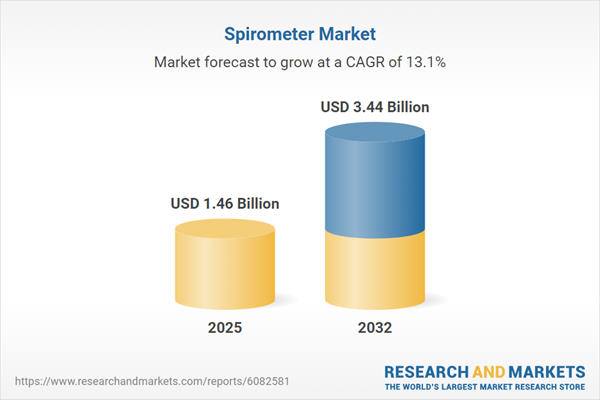Speak directly to the analyst to clarify any post sales queries you may have.
The global spirometer market is positioned for sustained advancement as healthcare systems prioritize improved respiratory diagnostics and operational excellence. Senior leaders need actionable insights to adapt strategies in response to rapid technological development, evolving regulations, and wider shifts across care environments.
Market Snapshot: Spirometer Market Size, Growth, and Outlook
The spirometer market grew from USD 1.29 billion in 2024 to USD 1.46 billion in 2025. Forecasts indicate further growth at a CAGR of 13.07%, with revenue projected to reach USD 3.44 billion by 2032. This upward trend is underpinned by increasing incidence of chronic respiratory conditions, strategic adoption of telehealth models, and significant advancements in sensor technologies. As device integration within healthcare workflows expands, decision-makers must leverage timely intelligence to guide efficient procurement and respond agilely to dynamic sector trends.
Spirometer Market Scope & Segmentation
This research delivers a comprehensive analysis of the spirometer market, structured to help strategic planners, procurement heads, and innovation leaders seize opportunities and minimize exposure:
- End Users: Ambulatory surgical centers, clinics, homecare centers, hospitals, and research laboratories are adopting spirometry for routine diagnostics, enhanced patient monitoring, and evidence-based clinical research.
- Product Types: Desktop devices, portable formats, and stationary solutions cater to varied diagnostic settings, optimizing both mobility requirements and data accuracy across institutions.
- Techniques: Fleisch systems excel in research due to reproducibility; turbine models offer flexible operation, while ultrasonic technology prioritizes patient comfort and rapid, non-invasive assessment.
- Applications: Adult protocols allow for broad measurement needs, whereas pediatric configurations are tailored for safety and usability through size-adjusted accessories.
- Sales Channels: Offline distribution supports institutional buying cycles; online channels are gaining traction with remote and decentralized clinics seeking direct procurement options.
- Geographic Regions: The Americas (including United States, Canada, Mexico, Brazil, Argentina, Chile, Colombia, Peru), EMEA (highlighting UK, Germany, France, Russia, Italy, Spain, UAE, Saudi Arabia), and Asia-Pacific (covering China, India, Japan, Australia, South Korea, Indonesia, Thailand, Malaysia, Singapore, Taiwan) each exhibit unique drivers and regulatory considerations influencing adoption rates.
- Major Companies Analyzed: Koninklijke Philips N.V., ResMed Inc., General Electric Company, Vyaire Medical, ndd Medizintechnik AG, COSMED S.r.l., MGC Diagnostics Corporation, Vitalograph Limited, Medical International Research S.r.l., Schiller AG represent primary industry stakeholders shaping innovation and global supply.
Spirometer Market: Key Takeaways for Strategic Leaders
- Healthcare provider demand for next-generation spirometry is fueled by needs for seamless integration with electronic health records and optimized clinical workflows.
- Advances in miniaturization and sensor accuracy are extending the reach of spirometry beyond clinical settings, significantly enabling home-based and remote monitoring scenarios.
- The pairing of mobile applications with spirometry supports active patient participation and strengthens clinician oversight, which contributes to earlier detection and proactive disease management.
- Industry collaboration on device interoperability and evolving regulatory frameworks ensures compatibility and compliance across hospitals, clinics, and decentralized environments.
- Procurement strategies are being reevaluated as online channels expand access for distributed care providers while traditional distributors continue to support hospital networks with robust supply capabilities.
Tariff Impact: Navigating U.S. Trade Policy and Supply Chain Adjustments
U.S. tariff changes set for 2025 are influencing the cost and structure of imported spirometer components and finished products. Manufacturers are responding by moving production phases closer to key markets, which helps reduce tariff exposure and boost supply agility. Localized assembly introduces demands for additional investment and rigorous quality checks, while closer coordination among component suppliers, contract firms, and product developers is strengthening operational risk management and supply transparency. These responses are prompting shifts in global production strategy and the formation of new cross-border partnerships to help maintain continuity and mitigate future risks.
Methodology & Data Sources
This report is based on a rigorous hybrid approach, combining in-depth interviews with healthcare professionals, manufacturers, and supply chain experts, with a detailed secondary analysis of core industry publications and regulatory materials. Layered segmentation and robust quality protocols ensure insights are reliable and relevant to the evolving spirometer ecosystem.
Why This Report Matters
- Clarifies the complex interplay among device innovation, compliance standards, and shifting care delivery models to support effective decision-making in the spirometer sector.
- Details actionable ways to mitigate risks associated with supply chain disruption, tariff changes, and region-specific market access constraints.
- Provides practical insights for growth strategies through tailored segmentation and adoption trends relevant to varied international markets.
Conclusion
This spirometer market analysis delivers the strategic context executives need to navigate transforming technologies, supply uncertainties, and regulatory complexities. Informed leaders can confidently advance adoption initiatives and protect their organizational position as the market continues its evolution.
Table of Contents
3. Executive Summary
4. Market Overview
7. Cumulative Impact of Artificial Intelligence 2025
Companies Mentioned
The companies profiled in this Spirometer market report include:- Koninklijke Philips N.V.
- ResMed Inc.
- General Electric Company
- Vyaire Medical, Inc.
- ndd Medizintechnik AG
- COSMED S.r.l.
- MGC Diagnostics Corporation
- Vitalograph Limited
- Medical International Research S.r.l.
- Schiller AG
Table Information
| Report Attribute | Details |
|---|---|
| No. of Pages | 190 |
| Published | October 2025 |
| Forecast Period | 2025 - 2032 |
| Estimated Market Value ( USD | $ 1.46 Billion |
| Forecasted Market Value ( USD | $ 3.44 Billion |
| Compound Annual Growth Rate | 13.0% |
| Regions Covered | Global |
| No. of Companies Mentioned | 11 |









